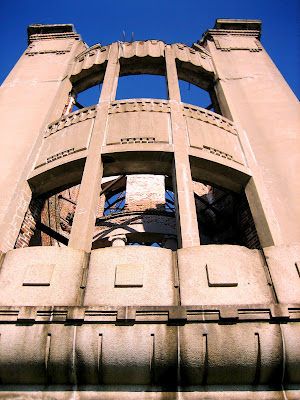The building now known as the A-bomb Dome was designed by Czech architect Jan Letzel. Completed in April 1915, the Hiroshima Prefectural Commercial Exhibition Hall soon became a beloved Hiroshima landmark with its distinctive green dome.
While business functions included commercial research and consulting services and the display and sale of prefectural products, the hall was also used for art exhibitions, fairs, and cultural events.
Through the years, it took on new functions and was renamed the Hiroshima Prefectural Products Exhibition Hall, then the Hiroshima Prefectural Industrial Promotion Hall. As the war intensified, however, the hall was taken over by the Chugoku-Shikoku Public Works Office of the Interior Ministry, the Hiroshima District Lumber Control Corporation, and other government agencies.
Because the blast struck from almost directly above, some of the center walls remained standing, leaving enough of the building and iron frame to be recognizable as a dome.
After the war, these dramatic remains came to be known as the A-bomb Dome.
For many years, public opinions about the dome remained divided. Some felt it should be preserved as a memorial to the bombing, while others thought it should be destroyed as a dangerously dilapidated structure evoking painful memories.
As the city was rebuild and other A-bombed buildings vanished, the voices calling for preservation gathered strength. In 1966, the Hiroshima City Council passed a resolution to preserve the A-dome Dome, which led to a public fundraising campaign to finance the construction work. Donations poured in which wishes for peace from around Japan and overseas, making the first preservation project possible in 1967.
Several preservation projects have been carried out to ensure that the dome will always look as it did immediately after the bombing.
In December 1996, the A-bomb Dome was registered on the World Heritage List as a historical witness conveying the horror of the first use of a nuclear weapon, ans as a world peace monument appealing continually for lasting peace and the abolition of such weapons.
To help protect the dome, the national government designated the area around it as a historic site under the Cultural Properties Protection Act, with a larger area in and around Peace Memorial Park set aside as a buffer zone.







Certainly an important topic. Can you provide citations for the historical facts you present?
ReplyDelete